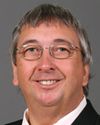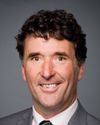Mr. Speaker, today I am very pleased to speak in favour of passing this bill, which is very important to me and to many of my colleagues in this House. I would like to repeat what I said yesterday during a ceremony that took place following the government's introduction of this bill in the House.
The first thing I did yesterday, and I will do it again today, is to thank and salute the board and staff of the Beechwood Cemetery, some of whom I know are listening intently to the debate, and I will read the names.
It is appropriate that the people who have carried this project mostly so far be recognized: its chair, Grete Hale; Mr. Robert White, the treasurer; Margie Howsam the secretary; Mr. Richard Wagner; retired General Maurice Baril; Ian Guthrie; Stephen Gallagher; retired Brigadier General Gerry Peddle, Madame Ghyslaine Clément, who was assistant commissioner of the RCMP; Ms. Carol Beal; and the Deputy Commissioner of the RCMP, Tim Killam.
As I did yesterday, I saved the last gentlemen's name, David Roger, who has, at some point in the history of the cemetery been instrumental in preserving it and ensuring that, as an institution, its integrity was protected so that it could become what it is about the become, Canada's national cemetery.
I salute all these people for their constant, ceaseless volunteer work to make of this institutions what it is.
It does not go without some staff as well: Madame Sylvia Ceacero, Vera Yuzyk, and the predecessor to Sylvia, Tim Graham, I salute them for the work they have done over the years.
My second comments are to thank Parliament and the government.
A little over two years ago, on February 27, 2007, I introduced a bill in the House to make the Beechwood cemetery our national cemetery. At the time, I asked two of my colleagues for their support. One of them was to the right, literally or at least geographically: the member for Ottawa—Orléans. I did not have to ask twice; he agreed immediately and has always supported the idea. I also sought the support of my colleague to the left, geographically and perhaps otherwise: the member for Ottawa Centre, who also did not hesitate to support the bill.
My intention was to show that the initiative was completely non-partisan. That was true at the time and remains true today. I made it clear that if the government wanted to take over the bill and make it a government bill introduced in its name, I would have no problem with that. It has finally happened. And so I want to highlight the work and support of the Minister of the Environment, who brought the bill this far, and of his predecessor, the current Minister of Transport, Infrastructure and Communities, the member for Ottawa West—Nepean. This is an excellent example of collaboration.
I have also engaged in an ongoing dialogue on the subject with the member for Gatineau, because I do not want anyone in the House to feel injured or left out by this initiative. As the Leader of the Government in the House of Commons said at the beginning of the debate, this is an approach that Canadians are coming to appreciate and will certainly appreciate in this case.
I thought it was important it be done that way. If Beechwood Cemetery is to become a national one, as I said yesterday, I thought best that it be borne out of collaboration and not confrontation, out of harmony and not controversy, and that seems to have been achieved here.
After this debate, there will be two ultimate steps in the other chamber and royal sanction. I suspect and I hope the willingness of collaboration will manifest itself in these two last steps for this legislation to be fully enacted.
It brings me to the question of why we should have a national cemetery, and I think it has been touched upon. What is important is this institution be as close as possible a reflection of what Canada is, a pluralistic and an inclusive society.
Everyone has a place in our society.
We do not neglect the importance of our military history and the proof is in the pudding in that the military has chosen to have its national cemetery within the confines of Beechwood.
The same is true of the RCMP. This country operates under the rule of law, and that rule is fundamentally important to the very nature and fabric of our society. The RCMP has also chosen to make Beechwood its national cemetery. Thus, we have here two fundamental components of what makes up Canada and its history.
However, it goes way beyond that. As has been mentioned, in the Beechwood Cemetery are heads of state, elected officials, federal, provincial and municipal, scientists, industrialists, people from all walks of life beyond any partisanship. Sir Robert Borden is there as is Tommy Douglas, so it stands as the range of political persuasion in the country.
I am also one of those people who believe that linguistic duality is a fundamental and essential characteristic of Canada's future, of what it will become. In that regard, I must say, Beechwood has done an excellent job. That was an indispensable condition of my support for this institution's desire to become a national cemetery.
I commend Beechwood's efforts and achievements in this regard. Of course, by obtaining national cemetery status, the directors and managers of this institution understand that this must remain an enduring condition—in perpetuity—in order to continue to deserve this status of national cemetery.
Last year saw the pièce de résistance when the Governor General, our head of state, participated in the opening ceremony of the Beechwood National Memorial Centre at which its multi-dimensional, multi-ethnic and multi-denominational character was consecrated. Every religion is accepted at Beechwood and, indeed, they are all represented there harmoniously. Beechwood is, I think, what a Canadian national cemetery should be: a reflection of its society.
However, one element seemed to be lacking. Over the last two weeks, somehow this element is being solved. Two weeks ago, the Ottawa Citizen ran a story, written by Randy Boswell, about a gentleman by the name of James Creighton, who, according to our Prime Minister, is the closest thing Canada has to a founding father of hockey. This gentleman is buried in Beechwood Cemetery in an unmarked grave.
His is a long and interesting story. Essentially, the Society for International Hockey Research has determined that this gentleman had been at the forefront of defining the modern rules of hockey as it is practised today. This gentleman also was for 48 years the law clerk of the Senate. When he died, I believe 1930, within a week, his wife also died. As a consequence of that, he remained buried at Beechwood in an unmarked grave. The Society for International Hockey Research found this out and hoped to raise enough money to have a suitable headstone erected in his honour. That story was carried in the local newspaper two weeks ago.
I then called the Ottawa Senators, both the hockey club and the ones in the upper chamber, to see if the money could be raised so the headstone could be prepared and erected. I am happy to say that not only a number of people reacted positively, but Beechwood Cemetery itself has given us pledge money. The Ottawa Senator's owner has also. Our colleagues in the upper chamber are pondering it. I believe that some time in the spring this last element will be fulfilled. How could it not be any other way, that our national cemetery would also honour our national winter sport.
I am very proud to say that a headstone will indeed be arranged and erected for this man.
The final step for me is to hope that our colleagues in the other chamber, Senators Dallaire, Keon, Munsen and the Government Leader in the Senate, Madame LeBreton, who have all been involved with this, will ensure that this is carried out promptly and that we can all take some pride in this achievement of Parliament, as we are doing here today.







